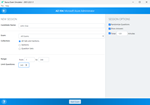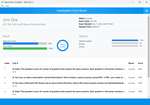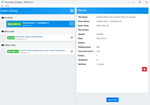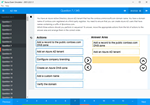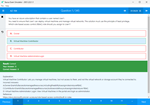Download Java EE 6 Enterprise JavaBeans Developer Certified Expert.1z0-895.Train4Sure.2017-12-19.90q.tqb
| Vendor: | Oracle |
| Exam Code: | 1z0-895 |
| Exam Name: | Java EE 6 Enterprise JavaBeans Developer Certified Expert |
| Date: | Dec 19, 2017 |
| File Size: | 4 MB |
How to open TQB files?
Files with TQB (Taurus Question Bank) extension can be opened by Taurus Exam Studio.
Purchase
Coupon: TAURUSSIM_20OFF
Discount: 20%
Demo Questions
Question 1
A developer needs to deliver a large-scale enterprise application that connects developer chooses an EJB 3.1-compliant application server, which three are true about the EJB business component tier? (Choose three.)
- Load-balancing is NOT a guarantee for all EJB 3.1 containers.
- Clustering is guaranteed to be supported by the EJB 3.1 container.
- Thread pooling can be optimized by the Bean Provider programmatically.
- Bean Providers are NOT required to write code for transaction demarcation.
- Support for server fail-over is guaranteed for an EJB 3.1-compliant application server.
- EJB 3.1 compliant components are guaranteed to work within any Java EE 6 application server
Correct answer: ADF
Explanation:
The EJB tier hosts the business logic of a J2EE application and provides system-level services to the business components problems include state maintenance, transaction management, and availability to local and remote clients. The EJB tier hosts the business logic of a J2EE application and provides system-level services to the business components problems include state maintenance, transaction management, and availability to local and remote clients.
Question 2
A developer examines a list of potential enterprise applications and selects the most appropriate technologies to use for each application.
For which two applications is EJB an appropriate solution? (Choose two.)
- To render a GUI for mobile clients.
- As a container for web-tier components including JSP.
- As a Web service endpoint accessed by non-Java clients.
- To receive and respond to HTTP Post requests directly from a web browser.
- As an online shopping cart which can persist across multiple sessions with a single client.
Correct answer: CE
Question 3
Which two statements are true? (Choose two.)
- Typically, remotely accessible objects should be coarse-grained.
- If a client accesses an enterprise bean locally such access must be mediated by the EJB container.
- A given enterprise bean's transaction information is immutable because it is deployed across various containers.
- If a container provides services NOT required by the EJB specification, then that container is NOT considered to be an EJB container.
- An enterprise bean's transaction Information can be accessed by external tools only if the information is contained in an XML deployment descriptor.
Correct answer: AB
Explanation:
Enterprise JavaBeans 3.1, Final Release: 3.2.3 Choosing Between a Local or Remote Client View Remote calls are potentially expensive. They involve network latency, overhead of the client and server software stacks, argument copying, etc. Remote calls are typically programmed in a coarse-grained manner with few interactions between the client and bean.21.3 Container Provider’s Responsibility This section defines the container’s responsibilities for providing the runtime environment to the enterprise bean instances. The requirements described here are considered to be the minimal requirements; a container may choose to provide additional functionality that is not required by the EJB specification. Enterprise JavaBeans 3.1, Final Release: 3.2.3 Choosing Between a Local or Remote Client View Remote calls are potentially expensive. They involve network latency, overhead of the client and server software stacks, argument copying, etc. Remote calls are typically programmed in a coarse-grained manner with few interactions between the client and bean.
21.3 Container Provider’s Responsibility
This section defines the container’s responsibilities for providing the runtime environment to the enterprise bean instances. The requirements described here are considered to be the minimal requirements; a container may choose to provide additional functionality that is not required by the EJB specification.
Question 4
Assume you would like to receive notification from the container as a stateless session bean transitions to and from the ready state.
Which of the following life cycle back annotations would you use? (Choose one.)
- @PostConstruct, @PostDestroy
- @PostConstruct, @PreDestroy
- @PreConstruct, @PostDestroy
- @PostConstruct, @PostDestroy, @Remove
- @PostConstruct, @PreDestroy, @Remove
Correct answer: B
Explanation:
The Lifecycle of a Stateless Session Bean The EJB container typically creates and maintains a pool of stateless session beans, beginning the stateless session bean’s lifecycle. The container performs any dependency injection and then invokes the method annotated @PostConstruct, if it exists. The bean is now ready to have its business methods invoked by a client. At the end of the lifecycle, the EJB container calls the method annotated @PreDestroy, if it exists. The bean’s instance is then ready for garbage collection. Lifecycle of a Stateless Session Bean: Note: An enterprise bean goes through various stages during its lifetime, or lifecycle. Each type of enterprise bean (stateful session, stateless session, singleton session, or message-driven) has a different lifecycle.Reference: http://docs.oracle.com/javaee/6/tutorial/doc/giplj.html The Lifecycle of a Stateless Session Bean
The EJB container typically creates and maintains a pool of stateless session beans, beginning the stateless session bean’s lifecycle. The container performs any dependency injection and then invokes the method annotated @PostConstruct, if it exists. The bean is now ready to have its business methods invoked by a client.
At the end of the lifecycle, the EJB container calls the method annotated @PreDestroy, if it exists. The bean’s instance is then ready for garbage collection.
Lifecycle of a Stateless Session Bean:

Note: An enterprise bean goes through various stages during its lifetime, or lifecycle. Each type of enterprise bean (stateful session, stateless session, singleton session, or message-driven) has a different lifecycle.
Reference: http://docs.oracle.com/javaee/6/tutorial/doc/giplj.html
Question 5
Which API must an EJB 3.1 container make available to enterprise beans at runtime?
- The JXTA 1.1 API
- The MIDP 2.0 API
- The Java SE 6 JNDI API
- The Java SE 5 JDBC API
Correct answer: C
HOW TO OPEN VCE FILES
Use VCE Exam Simulator to open VCE files

HOW TO OPEN VCEX FILES
Use ProfExam Simulator to open VCEX files


ProfExam at a 20% markdown
You have the opportunity to purchase ProfExam at a 20% reduced price
Get Now!